Deichmann: Workplace Discrimination and Employee Mental Health
VerifiedAdded on 2023/01/11
|34
|8974
|59
Report
AI Summary
This research report examines the impact of workplace discrimination on employee mental health and productivity, focusing on the German-based retail chain Deichmann. The report outlines the research aim, objectives, and questions, emphasizing the negative effects of discrimination on employee well-being and organizational performance. A literature review explores the influence of discrimination on employees, the impact on Deichmann's operations, and the link between workplace discrimination and mental health. The methodology includes a positivism research philosophy, a deductive approach, and a quantitative method using questionnaires. Data collection involves both primary and secondary sources, with a sample of 50 respondents. The report addresses ethical considerations, access to information, and the budget. The findings, presented in tables and qualitative interpretations, lead to conclusions and recommendations for mitigating discrimination and promoting mental health in the workplace. A reflection on alternative research methodologies is also included.
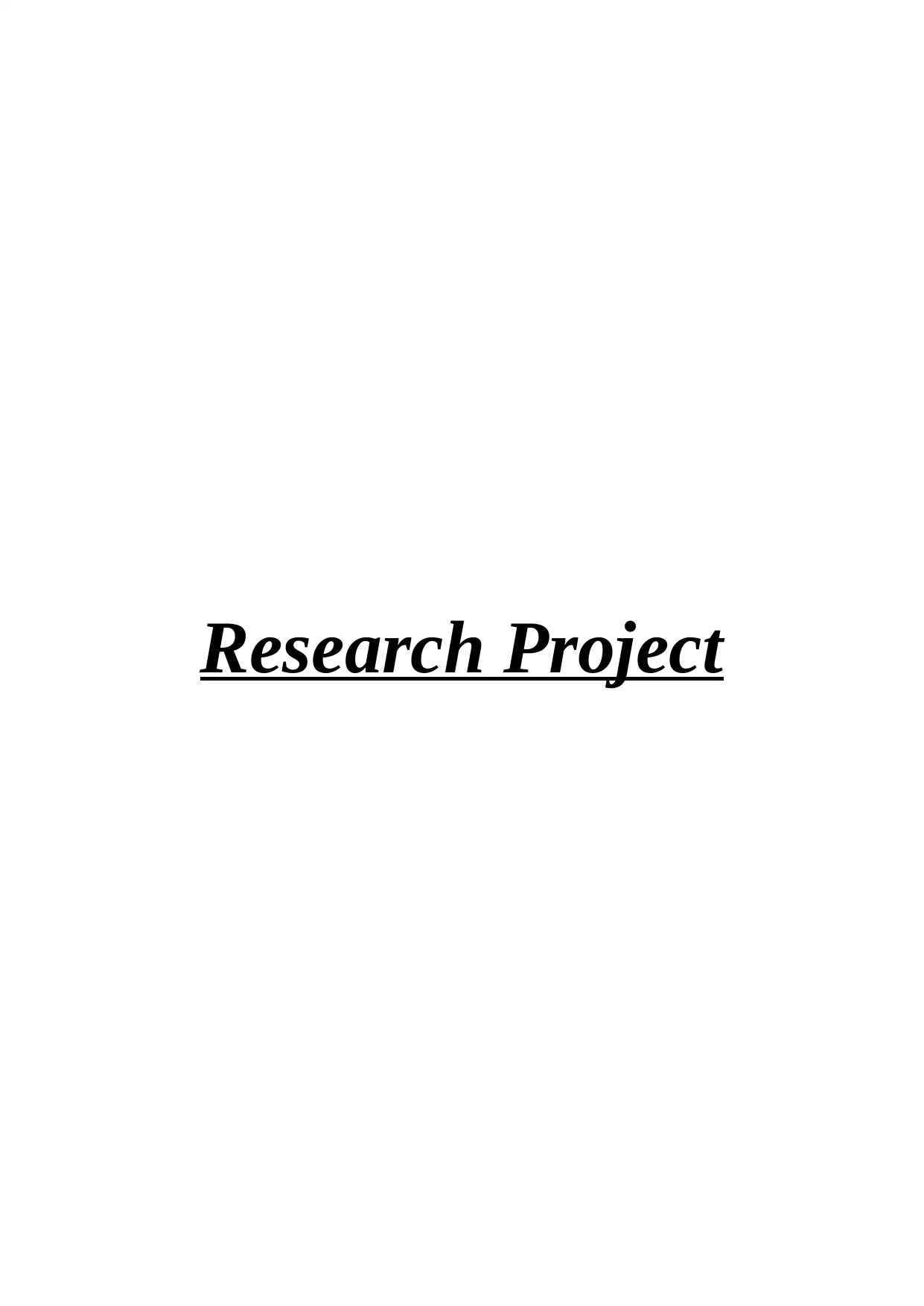
Research Project
Paraphrase This Document
Need a fresh take? Get an instant paraphrase of this document with our AI Paraphraser
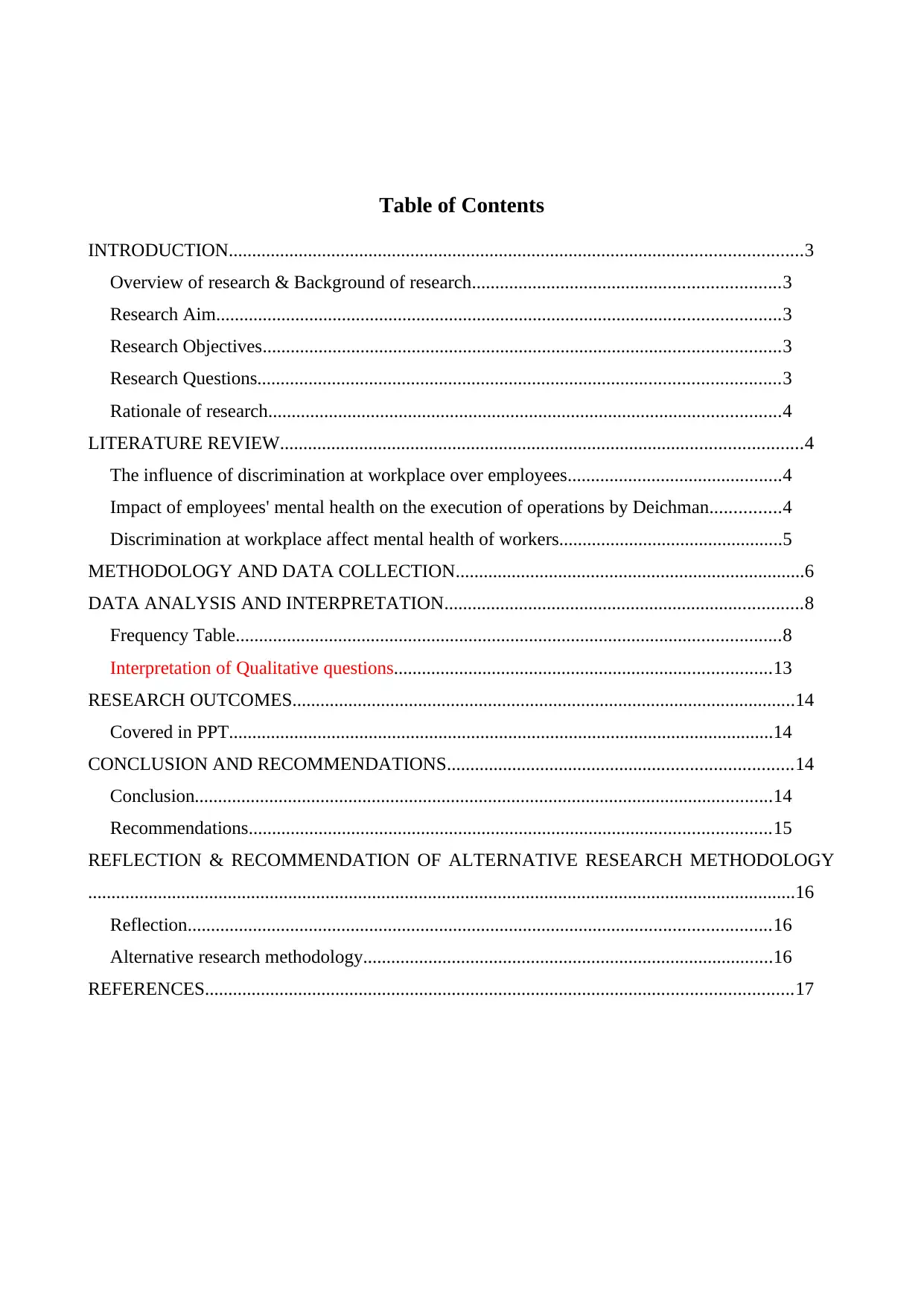
Table of Contents
INTRODUCTION...........................................................................................................................3
Overview of research & Background of research..................................................................3
Research Aim.........................................................................................................................3
Research Objectives...............................................................................................................3
Research Questions................................................................................................................3
Rationale of research..............................................................................................................4
LITERATURE REVIEW................................................................................................................4
The influence of discrimination at workplace over employees..............................................4
Impact of employees' mental health on the execution of operations by Deichman...............4
Discrimination at workplace affect mental health of workers................................................5
METHODOLOGY AND DATA COLLECTION...........................................................................6
DATA ANALYSIS AND INTERPRETATION.............................................................................8
Frequency Table.....................................................................................................................8
Interpretation of Qualitative questions.................................................................................13
RESEARCH OUTCOMES............................................................................................................14
Covered in PPT.....................................................................................................................14
CONCLUSION AND RECOMMENDATIONS..........................................................................14
Conclusion............................................................................................................................14
Recommendations................................................................................................................15
REFLECTION & RECOMMENDATION OF ALTERNATIVE RESEARCH METHODOLOGY
........................................................................................................................................................16
Reflection.............................................................................................................................16
Alternative research methodology........................................................................................16
REFERENCES..............................................................................................................................17
INTRODUCTION...........................................................................................................................3
Overview of research & Background of research..................................................................3
Research Aim.........................................................................................................................3
Research Objectives...............................................................................................................3
Research Questions................................................................................................................3
Rationale of research..............................................................................................................4
LITERATURE REVIEW................................................................................................................4
The influence of discrimination at workplace over employees..............................................4
Impact of employees' mental health on the execution of operations by Deichman...............4
Discrimination at workplace affect mental health of workers................................................5
METHODOLOGY AND DATA COLLECTION...........................................................................6
DATA ANALYSIS AND INTERPRETATION.............................................................................8
Frequency Table.....................................................................................................................8
Interpretation of Qualitative questions.................................................................................13
RESEARCH OUTCOMES............................................................................................................14
Covered in PPT.....................................................................................................................14
CONCLUSION AND RECOMMENDATIONS..........................................................................14
Conclusion............................................................................................................................14
Recommendations................................................................................................................15
REFLECTION & RECOMMENDATION OF ALTERNATIVE RESEARCH METHODOLOGY
........................................................................................................................................................16
Reflection.............................................................................................................................16
Alternative research methodology........................................................................................16
REFERENCES..............................................................................................................................17
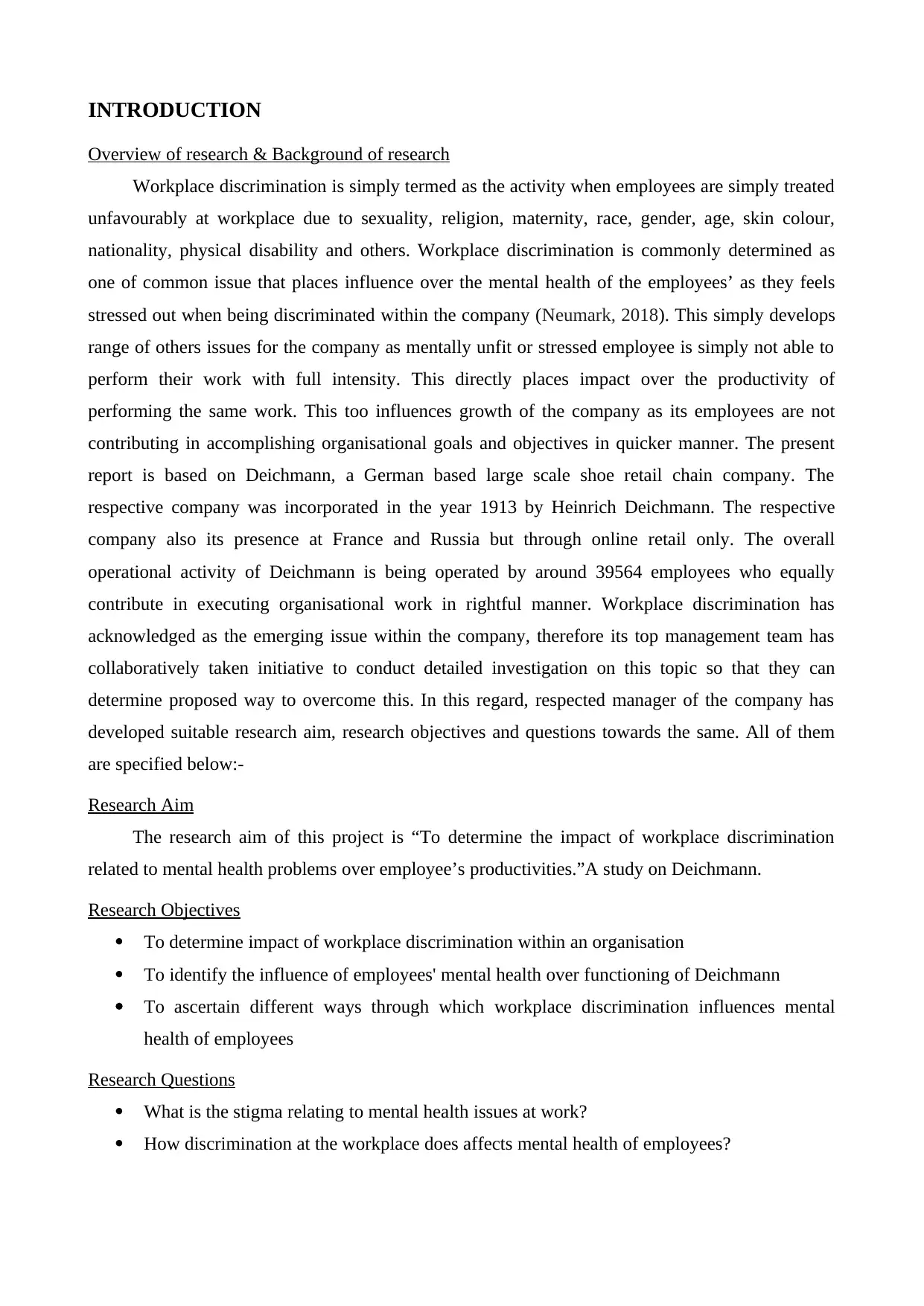
INTRODUCTION
Overview of research & Background of research
Workplace discrimination is simply termed as the activity when employees are simply treated
unfavourably at workplace due to sexuality, religion, maternity, race, gender, age, skin colour,
nationality, physical disability and others. Workplace discrimination is commonly determined as
one of common issue that places influence over the mental health of the employees’ as they feels
stressed out when being discriminated within the company (Neumark, 2018). This simply develops
range of others issues for the company as mentally unfit or stressed employee is simply not able to
perform their work with full intensity. This directly places impact over the productivity of
performing the same work. This too influences growth of the company as its employees are not
contributing in accomplishing organisational goals and objectives in quicker manner. The present
report is based on Deichmann, a German based large scale shoe retail chain company. The
respective company was incorporated in the year 1913 by Heinrich Deichmann. The respective
company also its presence at France and Russia but through online retail only. The overall
operational activity of Deichmann is being operated by around 39564 employees who equally
contribute in executing organisational work in rightful manner. Workplace discrimination has
acknowledged as the emerging issue within the company, therefore its top management team has
collaboratively taken initiative to conduct detailed investigation on this topic so that they can
determine proposed way to overcome this. In this regard, respected manager of the company has
developed suitable research aim, research objectives and questions towards the same. All of them
are specified below:-
Research Aim
The research aim of this project is “To determine the impact of workplace discrimination
related to mental health problems over employee’s productivities.”A study on Deichmann.
Research Objectives
To determine impact of workplace discrimination within an organisation
To identify the influence of employees' mental health over functioning of Deichmann
To ascertain different ways through which workplace discrimination influences mental
health of employees
Research Questions
What is the stigma relating to mental health issues at work?
How discrimination at the workplace does affects mental health of employees?
Overview of research & Background of research
Workplace discrimination is simply termed as the activity when employees are simply treated
unfavourably at workplace due to sexuality, religion, maternity, race, gender, age, skin colour,
nationality, physical disability and others. Workplace discrimination is commonly determined as
one of common issue that places influence over the mental health of the employees’ as they feels
stressed out when being discriminated within the company (Neumark, 2018). This simply develops
range of others issues for the company as mentally unfit or stressed employee is simply not able to
perform their work with full intensity. This directly places impact over the productivity of
performing the same work. This too influences growth of the company as its employees are not
contributing in accomplishing organisational goals and objectives in quicker manner. The present
report is based on Deichmann, a German based large scale shoe retail chain company. The
respective company was incorporated in the year 1913 by Heinrich Deichmann. The respective
company also its presence at France and Russia but through online retail only. The overall
operational activity of Deichmann is being operated by around 39564 employees who equally
contribute in executing organisational work in rightful manner. Workplace discrimination has
acknowledged as the emerging issue within the company, therefore its top management team has
collaboratively taken initiative to conduct detailed investigation on this topic so that they can
determine proposed way to overcome this. In this regard, respected manager of the company has
developed suitable research aim, research objectives and questions towards the same. All of them
are specified below:-
Research Aim
The research aim of this project is “To determine the impact of workplace discrimination
related to mental health problems over employee’s productivities.”A study on Deichmann.
Research Objectives
To determine impact of workplace discrimination within an organisation
To identify the influence of employees' mental health over functioning of Deichmann
To ascertain different ways through which workplace discrimination influences mental
health of employees
Research Questions
What is the stigma relating to mental health issues at work?
How discrimination at the workplace does affects mental health of employees?
⊘ This is a preview!⊘
Do you want full access?
Subscribe today to unlock all pages.

Trusted by 1+ million students worldwide
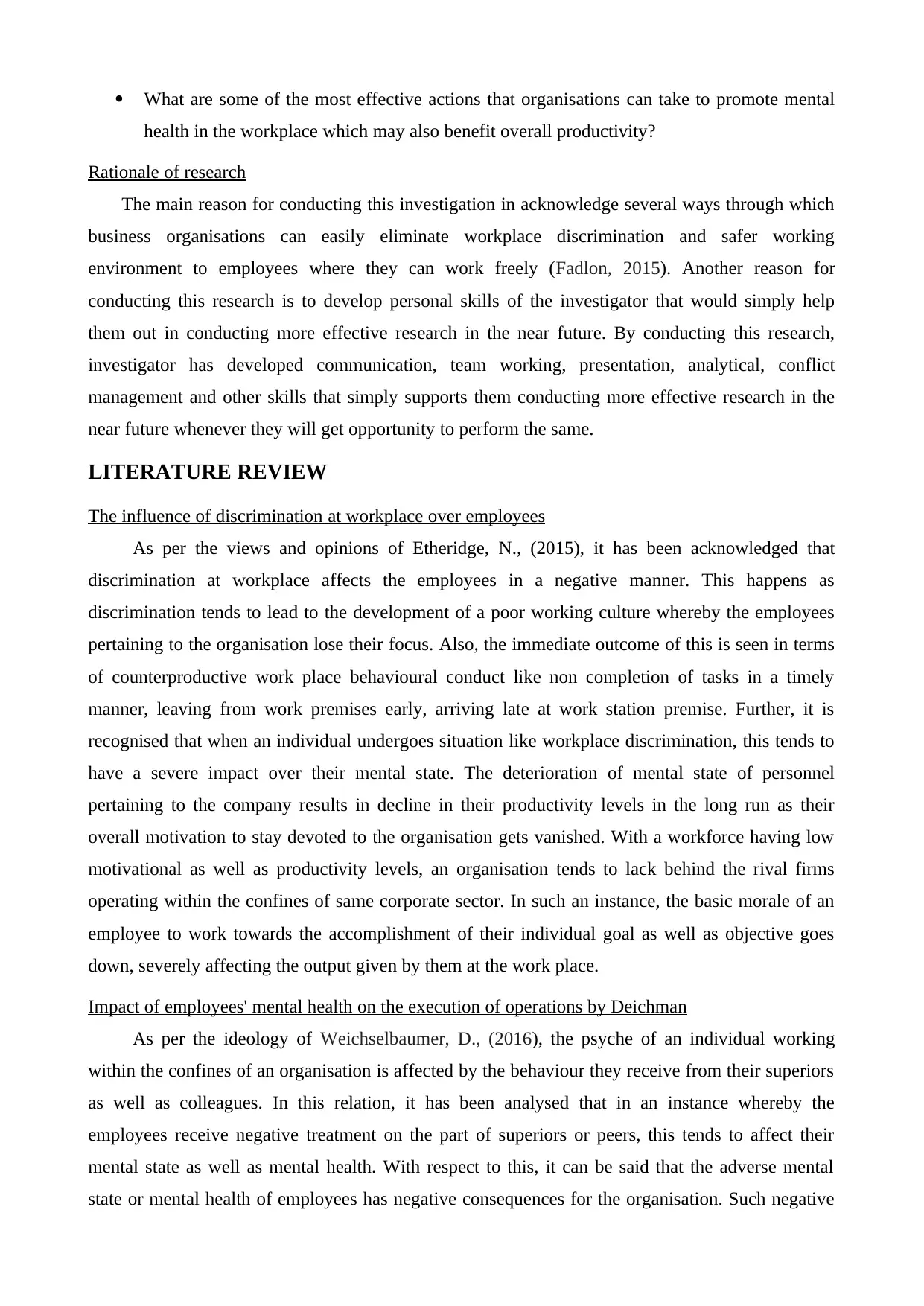
What are some of the most effective actions that organisations can take to promote mental
health in the workplace which may also benefit overall productivity?
Rationale of research
The main reason for conducting this investigation in acknowledge several ways through which
business organisations can easily eliminate workplace discrimination and safer working
environment to employees where they can work freely (Fadlon, 2015). Another reason for
conducting this research is to develop personal skills of the investigator that would simply help
them out in conducting more effective research in the near future. By conducting this research,
investigator has developed communication, team working, presentation, analytical, conflict
management and other skills that simply supports them conducting more effective research in the
near future whenever they will get opportunity to perform the same.
LITERATURE REVIEW
The influence of discrimination at workplace over employees
As per the views and opinions of Etheridge, N., (2015), it has been acknowledged that
discrimination at workplace affects the employees in a negative manner. This happens as
discrimination tends to lead to the development of a poor working culture whereby the employees
pertaining to the organisation lose their focus. Also, the immediate outcome of this is seen in terms
of counterproductive work place behavioural conduct like non completion of tasks in a timely
manner, leaving from work premises early, arriving late at work station premise. Further, it is
recognised that when an individual undergoes situation like workplace discrimination, this tends to
have a severe impact over their mental state. The deterioration of mental state of personnel
pertaining to the company results in decline in their productivity levels in the long run as their
overall motivation to stay devoted to the organisation gets vanished. With a workforce having low
motivational as well as productivity levels, an organisation tends to lack behind the rival firms
operating within the confines of same corporate sector. In such an instance, the basic morale of an
employee to work towards the accomplishment of their individual goal as well as objective goes
down, severely affecting the output given by them at the work place.
Impact of employees' mental health on the execution of operations by Deichman
As per the ideology of Weichselbaumer, D., (2016), the psyche of an individual working
within the confines of an organisation is affected by the behaviour they receive from their superiors
as well as colleagues. In this relation, it has been analysed that in an instance whereby the
employees receive negative treatment on the part of superiors or peers, this tends to affect their
mental state as well as mental health. With respect to this, it can be said that the adverse mental
state or mental health of employees has negative consequences for the organisation. Such negative
health in the workplace which may also benefit overall productivity?
Rationale of research
The main reason for conducting this investigation in acknowledge several ways through which
business organisations can easily eliminate workplace discrimination and safer working
environment to employees where they can work freely (Fadlon, 2015). Another reason for
conducting this research is to develop personal skills of the investigator that would simply help
them out in conducting more effective research in the near future. By conducting this research,
investigator has developed communication, team working, presentation, analytical, conflict
management and other skills that simply supports them conducting more effective research in the
near future whenever they will get opportunity to perform the same.
LITERATURE REVIEW
The influence of discrimination at workplace over employees
As per the views and opinions of Etheridge, N., (2015), it has been acknowledged that
discrimination at workplace affects the employees in a negative manner. This happens as
discrimination tends to lead to the development of a poor working culture whereby the employees
pertaining to the organisation lose their focus. Also, the immediate outcome of this is seen in terms
of counterproductive work place behavioural conduct like non completion of tasks in a timely
manner, leaving from work premises early, arriving late at work station premise. Further, it is
recognised that when an individual undergoes situation like workplace discrimination, this tends to
have a severe impact over their mental state. The deterioration of mental state of personnel
pertaining to the company results in decline in their productivity levels in the long run as their
overall motivation to stay devoted to the organisation gets vanished. With a workforce having low
motivational as well as productivity levels, an organisation tends to lack behind the rival firms
operating within the confines of same corporate sector. In such an instance, the basic morale of an
employee to work towards the accomplishment of their individual goal as well as objective goes
down, severely affecting the output given by them at the work place.
Impact of employees' mental health on the execution of operations by Deichman
As per the ideology of Weichselbaumer, D., (2016), the psyche of an individual working
within the confines of an organisation is affected by the behaviour they receive from their superiors
as well as colleagues. In this relation, it has been analysed that in an instance whereby the
employees receive negative treatment on the part of superiors or peers, this tends to affect their
mental state as well as mental health. With respect to this, it can be said that the adverse mental
state or mental health of employees has negative consequences for the organisation. Such negative
Paraphrase This Document
Need a fresh take? Get an instant paraphrase of this document with our AI Paraphraser
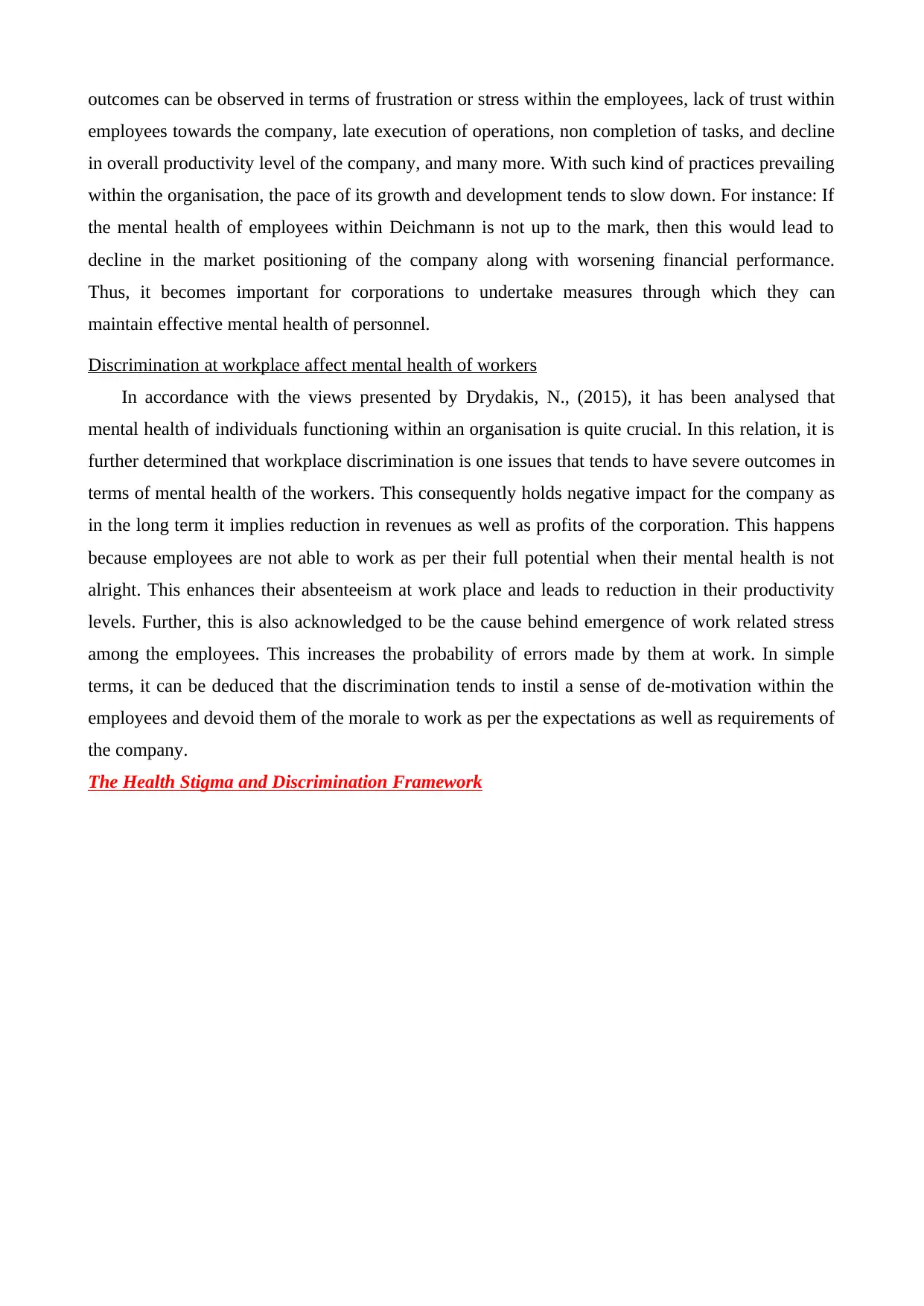
outcomes can be observed in terms of frustration or stress within the employees, lack of trust within
employees towards the company, late execution of operations, non completion of tasks, and decline
in overall productivity level of the company, and many more. With such kind of practices prevailing
within the organisation, the pace of its growth and development tends to slow down. For instance: If
the mental health of employees within Deichmann is not up to the mark, then this would lead to
decline in the market positioning of the company along with worsening financial performance.
Thus, it becomes important for corporations to undertake measures through which they can
maintain effective mental health of personnel.
Discrimination at workplace affect mental health of workers
In accordance with the views presented by Drydakis, N., (2015), it has been analysed that
mental health of individuals functioning within an organisation is quite crucial. In this relation, it is
further determined that workplace discrimination is one issues that tends to have severe outcomes in
terms of mental health of the workers. This consequently holds negative impact for the company as
in the long term it implies reduction in revenues as well as profits of the corporation. This happens
because employees are not able to work as per their full potential when their mental health is not
alright. This enhances their absenteeism at work place and leads to reduction in their productivity
levels. Further, this is also acknowledged to be the cause behind emergence of work related stress
among the employees. This increases the probability of errors made by them at work. In simple
terms, it can be deduced that the discrimination tends to instil a sense of de-motivation within the
employees and devoid them of the morale to work as per the expectations as well as requirements of
the company.
The Health Stigma and Discrimination Framework
employees towards the company, late execution of operations, non completion of tasks, and decline
in overall productivity level of the company, and many more. With such kind of practices prevailing
within the organisation, the pace of its growth and development tends to slow down. For instance: If
the mental health of employees within Deichmann is not up to the mark, then this would lead to
decline in the market positioning of the company along with worsening financial performance.
Thus, it becomes important for corporations to undertake measures through which they can
maintain effective mental health of personnel.
Discrimination at workplace affect mental health of workers
In accordance with the views presented by Drydakis, N., (2015), it has been analysed that
mental health of individuals functioning within an organisation is quite crucial. In this relation, it is
further determined that workplace discrimination is one issues that tends to have severe outcomes in
terms of mental health of the workers. This consequently holds negative impact for the company as
in the long term it implies reduction in revenues as well as profits of the corporation. This happens
because employees are not able to work as per their full potential when their mental health is not
alright. This enhances their absenteeism at work place and leads to reduction in their productivity
levels. Further, this is also acknowledged to be the cause behind emergence of work related stress
among the employees. This increases the probability of errors made by them at work. In simple
terms, it can be deduced that the discrimination tends to instil a sense of de-motivation within the
employees and devoid them of the morale to work as per the expectations as well as requirements of
the company.
The Health Stigma and Discrimination Framework
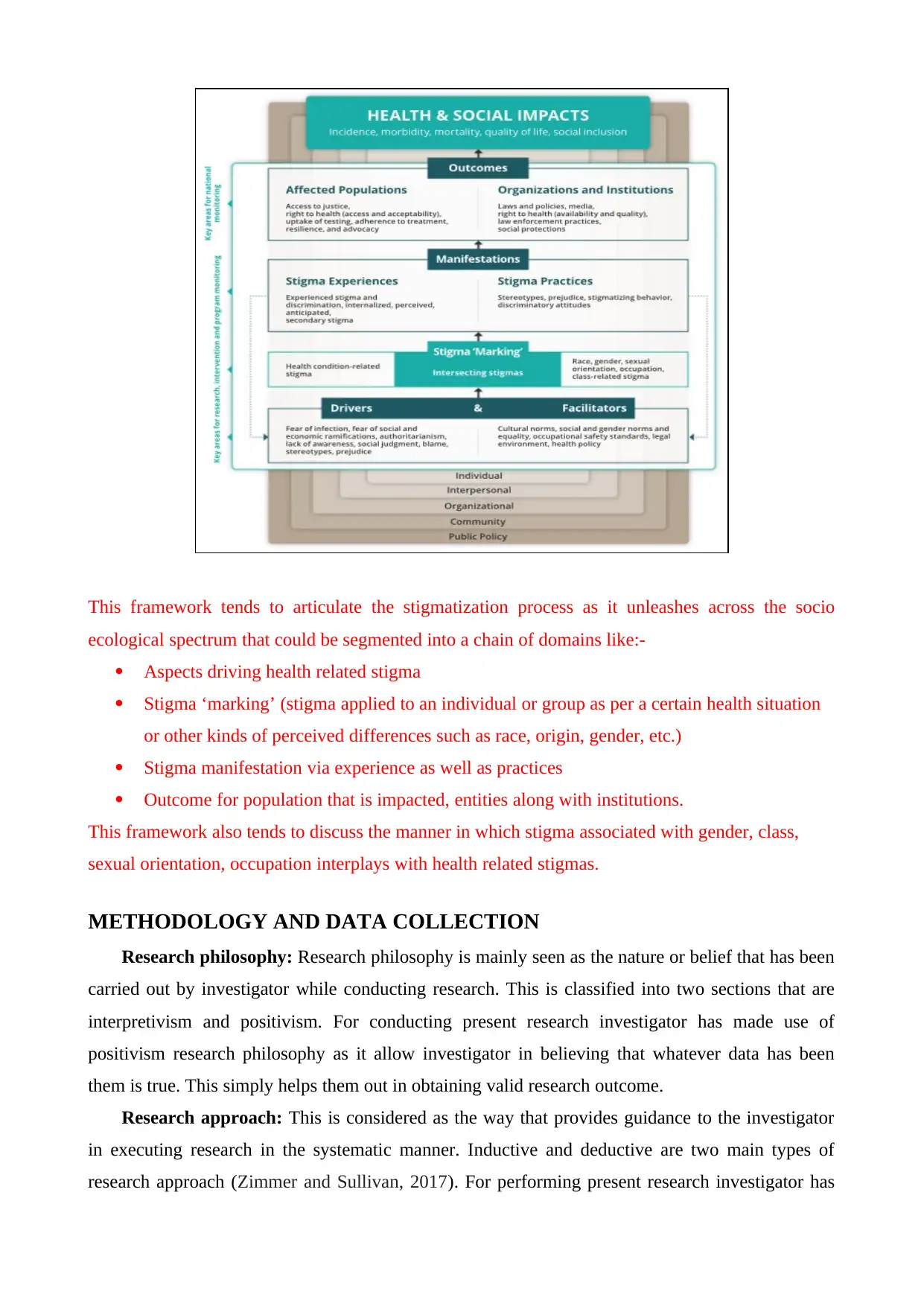
This framework tends to articulate the stigmatization process as it unleashes across the socio
ecological spectrum that could be segmented into a chain of domains like:-
Aspects driving health related stigma
Stigma ‘marking’ (stigma applied to an individual or group as per a certain health situation
or other kinds of perceived differences such as race, origin, gender, etc.)
Stigma manifestation via experience as well as practices
Outcome for population that is impacted, entities along with institutions.
This framework also tends to discuss the manner in which stigma associated with gender, class,
sexual orientation, occupation interplays with health related stigmas.
METHODOLOGY AND DATA COLLECTION
Research philosophy: Research philosophy is mainly seen as the nature or belief that has been
carried out by investigator while conducting research. This is classified into two sections that are
interpretivism and positivism. For conducting present research investigator has made use of
positivism research philosophy as it allow investigator in believing that whatever data has been
them is true. This simply helps them out in obtaining valid research outcome.
Research approach: This is considered as the way that provides guidance to the investigator
in executing research in the systematic manner. Inductive and deductive are two main types of
research approach (Zimmer and Sullivan, 2017). For performing present research investigator has
ecological spectrum that could be segmented into a chain of domains like:-
Aspects driving health related stigma
Stigma ‘marking’ (stigma applied to an individual or group as per a certain health situation
or other kinds of perceived differences such as race, origin, gender, etc.)
Stigma manifestation via experience as well as practices
Outcome for population that is impacted, entities along with institutions.
This framework also tends to discuss the manner in which stigma associated with gender, class,
sexual orientation, occupation interplays with health related stigmas.
METHODOLOGY AND DATA COLLECTION
Research philosophy: Research philosophy is mainly seen as the nature or belief that has been
carried out by investigator while conducting research. This is classified into two sections that are
interpretivism and positivism. For conducting present research investigator has made use of
positivism research philosophy as it allow investigator in believing that whatever data has been
them is true. This simply helps them out in obtaining valid research outcome.
Research approach: This is considered as the way that provides guidance to the investigator
in executing research in the systematic manner. Inductive and deductive are two main types of
research approach (Zimmer and Sullivan, 2017). For performing present research investigator has
⊘ This is a preview!⊘
Do you want full access?
Subscribe today to unlock all pages.

Trusted by 1+ million students worldwide
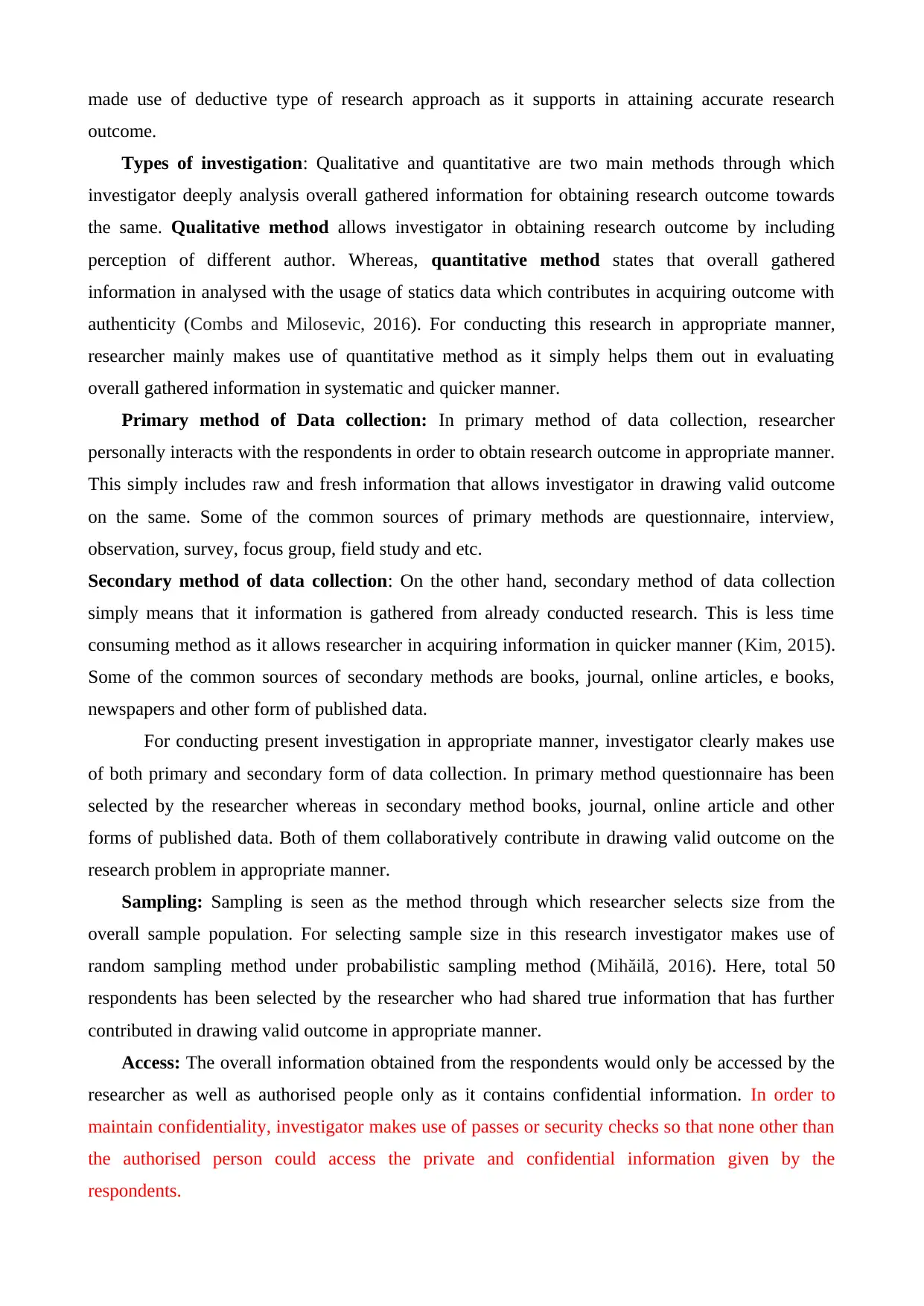
made use of deductive type of research approach as it supports in attaining accurate research
outcome.
Types of investigation: Qualitative and quantitative are two main methods through which
investigator deeply analysis overall gathered information for obtaining research outcome towards
the same. Qualitative method allows investigator in obtaining research outcome by including
perception of different author. Whereas, quantitative method states that overall gathered
information in analysed with the usage of statics data which contributes in acquiring outcome with
authenticity (Combs and Milosevic, 2016). For conducting this research in appropriate manner,
researcher mainly makes use of quantitative method as it simply helps them out in evaluating
overall gathered information in systematic and quicker manner.
Primary method of Data collection: In primary method of data collection, researcher
personally interacts with the respondents in order to obtain research outcome in appropriate manner.
This simply includes raw and fresh information that allows investigator in drawing valid outcome
on the same. Some of the common sources of primary methods are questionnaire, interview,
observation, survey, focus group, field study and etc.
Secondary method of data collection: On the other hand, secondary method of data collection
simply means that it information is gathered from already conducted research. This is less time
consuming method as it allows researcher in acquiring information in quicker manner (Kim, 2015).
Some of the common sources of secondary methods are books, journal, online articles, e books,
newspapers and other form of published data.
For conducting present investigation in appropriate manner, investigator clearly makes use
of both primary and secondary form of data collection. In primary method questionnaire has been
selected by the researcher whereas in secondary method books, journal, online article and other
forms of published data. Both of them collaboratively contribute in drawing valid outcome on the
research problem in appropriate manner.
Sampling: Sampling is seen as the method through which researcher selects size from the
overall sample population. For selecting sample size in this research investigator makes use of
random sampling method under probabilistic sampling method (Mihăilă, 2016). Here, total 50
respondents has been selected by the researcher who had shared true information that has further
contributed in drawing valid outcome in appropriate manner.
Access: The overall information obtained from the respondents would only be accessed by the
researcher as well as authorised people only as it contains confidential information. In order to
maintain confidentiality, investigator makes use of passes or security checks so that none other than
the authorised person could access the private and confidential information given by the
respondents.
outcome.
Types of investigation: Qualitative and quantitative are two main methods through which
investigator deeply analysis overall gathered information for obtaining research outcome towards
the same. Qualitative method allows investigator in obtaining research outcome by including
perception of different author. Whereas, quantitative method states that overall gathered
information in analysed with the usage of statics data which contributes in acquiring outcome with
authenticity (Combs and Milosevic, 2016). For conducting this research in appropriate manner,
researcher mainly makes use of quantitative method as it simply helps them out in evaluating
overall gathered information in systematic and quicker manner.
Primary method of Data collection: In primary method of data collection, researcher
personally interacts with the respondents in order to obtain research outcome in appropriate manner.
This simply includes raw and fresh information that allows investigator in drawing valid outcome
on the same. Some of the common sources of primary methods are questionnaire, interview,
observation, survey, focus group, field study and etc.
Secondary method of data collection: On the other hand, secondary method of data collection
simply means that it information is gathered from already conducted research. This is less time
consuming method as it allows researcher in acquiring information in quicker manner (Kim, 2015).
Some of the common sources of secondary methods are books, journal, online articles, e books,
newspapers and other form of published data.
For conducting present investigation in appropriate manner, investigator clearly makes use
of both primary and secondary form of data collection. In primary method questionnaire has been
selected by the researcher whereas in secondary method books, journal, online article and other
forms of published data. Both of them collaboratively contribute in drawing valid outcome on the
research problem in appropriate manner.
Sampling: Sampling is seen as the method through which researcher selects size from the
overall sample population. For selecting sample size in this research investigator makes use of
random sampling method under probabilistic sampling method (Mihăilă, 2016). Here, total 50
respondents has been selected by the researcher who had shared true information that has further
contributed in drawing valid outcome in appropriate manner.
Access: The overall information obtained from the respondents would only be accessed by the
researcher as well as authorised people only as it contains confidential information. In order to
maintain confidentiality, investigator makes use of passes or security checks so that none other than
the authorised person could access the private and confidential information given by the
respondents.
Paraphrase This Document
Need a fresh take? Get an instant paraphrase of this document with our AI Paraphraser
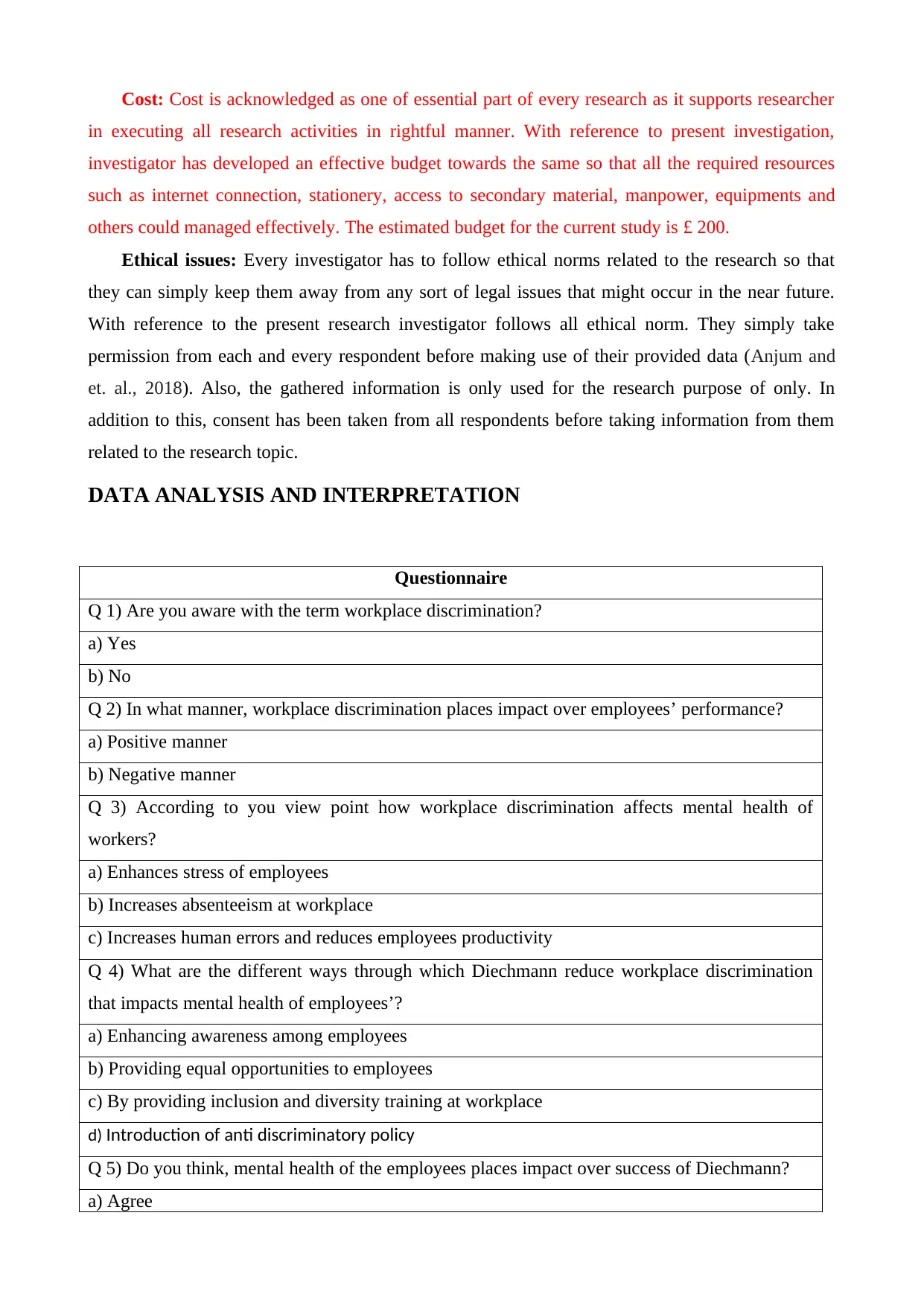
Cost: Cost is acknowledged as one of essential part of every research as it supports researcher
in executing all research activities in rightful manner. With reference to present investigation,
investigator has developed an effective budget towards the same so that all the required resources
such as internet connection, stationery, access to secondary material, manpower, equipments and
others could managed effectively. The estimated budget for the current study is £ 200.
Ethical issues: Every investigator has to follow ethical norms related to the research so that
they can simply keep them away from any sort of legal issues that might occur in the near future.
With reference to the present research investigator follows all ethical norm. They simply take
permission from each and every respondent before making use of their provided data (Anjum and
et. al., 2018). Also, the gathered information is only used for the research purpose of only. In
addition to this, consent has been taken from all respondents before taking information from them
related to the research topic.
DATA ANALYSIS AND INTERPRETATION
Questionnaire
Q 1) Are you aware with the term workplace discrimination?
a) Yes
b) No
Q 2) In what manner, workplace discrimination places impact over employees’ performance?
a) Positive manner
b) Negative manner
Q 3) According to you view point how workplace discrimination affects mental health of
workers?
a) Enhances stress of employees
b) Increases absenteeism at workplace
c) Increases human errors and reduces employees productivity
Q 4) What are the different ways through which Diechmann reduce workplace discrimination
that impacts mental health of employees’?
a) Enhancing awareness among employees
b) Providing equal opportunities to employees
c) By providing inclusion and diversity training at workplace
d) Introduction of anti discriminatory policy
Q 5) Do you think, mental health of the employees places impact over success of Diechmann?
a) Agree
in executing all research activities in rightful manner. With reference to present investigation,
investigator has developed an effective budget towards the same so that all the required resources
such as internet connection, stationery, access to secondary material, manpower, equipments and
others could managed effectively. The estimated budget for the current study is £ 200.
Ethical issues: Every investigator has to follow ethical norms related to the research so that
they can simply keep them away from any sort of legal issues that might occur in the near future.
With reference to the present research investigator follows all ethical norm. They simply take
permission from each and every respondent before making use of their provided data (Anjum and
et. al., 2018). Also, the gathered information is only used for the research purpose of only. In
addition to this, consent has been taken from all respondents before taking information from them
related to the research topic.
DATA ANALYSIS AND INTERPRETATION
Questionnaire
Q 1) Are you aware with the term workplace discrimination?
a) Yes
b) No
Q 2) In what manner, workplace discrimination places impact over employees’ performance?
a) Positive manner
b) Negative manner
Q 3) According to you view point how workplace discrimination affects mental health of
workers?
a) Enhances stress of employees
b) Increases absenteeism at workplace
c) Increases human errors and reduces employees productivity
Q 4) What are the different ways through which Diechmann reduce workplace discrimination
that impacts mental health of employees’?
a) Enhancing awareness among employees
b) Providing equal opportunities to employees
c) By providing inclusion and diversity training at workplace
d) Introduction of anti discriminatory policy
Q 5) Do you think, mental health of the employees places impact over success of Diechmann?
a) Agree
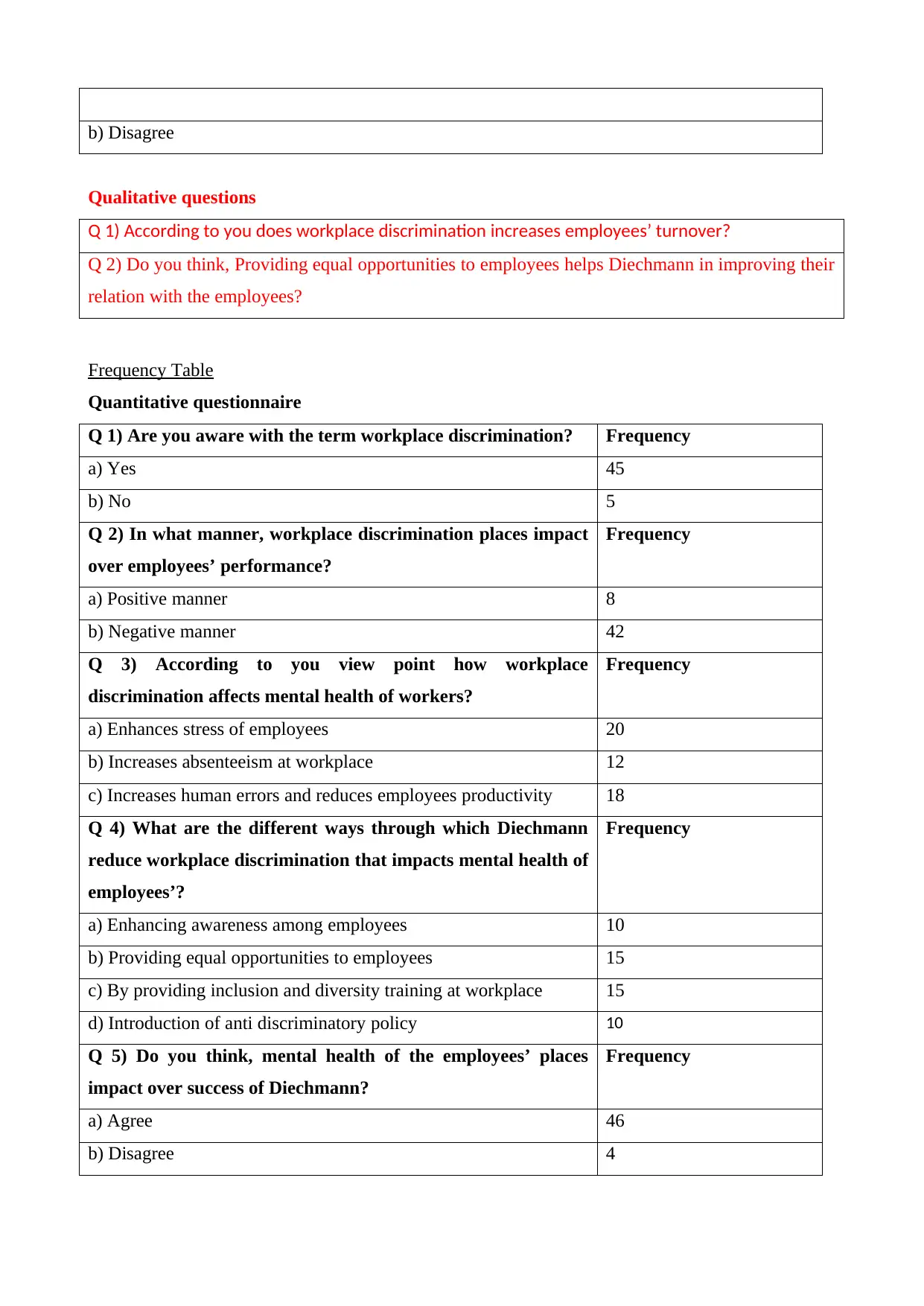
b) Disagree
Qualitative questions
Q 1) According to you does workplace discrimination increases employees’ turnover?
Q 2) Do you think, Providing equal opportunities to employees helps Diechmann in improving their
relation with the employees?
Frequency Table
Quantitative questionnaire
Q 1) Are you aware with the term workplace discrimination? Frequency
a) Yes 45
b) No 5
Q 2) In what manner, workplace discrimination places impact
over employees’ performance?
Frequency
a) Positive manner 8
b) Negative manner 42
Q 3) According to you view point how workplace
discrimination affects mental health of workers?
Frequency
a) Enhances stress of employees 20
b) Increases absenteeism at workplace 12
c) Increases human errors and reduces employees productivity 18
Q 4) What are the different ways through which Diechmann
reduce workplace discrimination that impacts mental health of
employees’?
Frequency
a) Enhancing awareness among employees 10
b) Providing equal opportunities to employees 15
c) By providing inclusion and diversity training at workplace 15
d) Introduction of anti discriminatory policy 10
Q 5) Do you think, mental health of the employees’ places
impact over success of Diechmann?
Frequency
a) Agree 46
b) Disagree 4
Qualitative questions
Q 1) According to you does workplace discrimination increases employees’ turnover?
Q 2) Do you think, Providing equal opportunities to employees helps Diechmann in improving their
relation with the employees?
Frequency Table
Quantitative questionnaire
Q 1) Are you aware with the term workplace discrimination? Frequency
a) Yes 45
b) No 5
Q 2) In what manner, workplace discrimination places impact
over employees’ performance?
Frequency
a) Positive manner 8
b) Negative manner 42
Q 3) According to you view point how workplace
discrimination affects mental health of workers?
Frequency
a) Enhances stress of employees 20
b) Increases absenteeism at workplace 12
c) Increases human errors and reduces employees productivity 18
Q 4) What are the different ways through which Diechmann
reduce workplace discrimination that impacts mental health of
employees’?
Frequency
a) Enhancing awareness among employees 10
b) Providing equal opportunities to employees 15
c) By providing inclusion and diversity training at workplace 15
d) Introduction of anti discriminatory policy 10
Q 5) Do you think, mental health of the employees’ places
impact over success of Diechmann?
Frequency
a) Agree 46
b) Disagree 4
⊘ This is a preview!⊘
Do you want full access?
Subscribe today to unlock all pages.

Trusted by 1+ million students worldwide
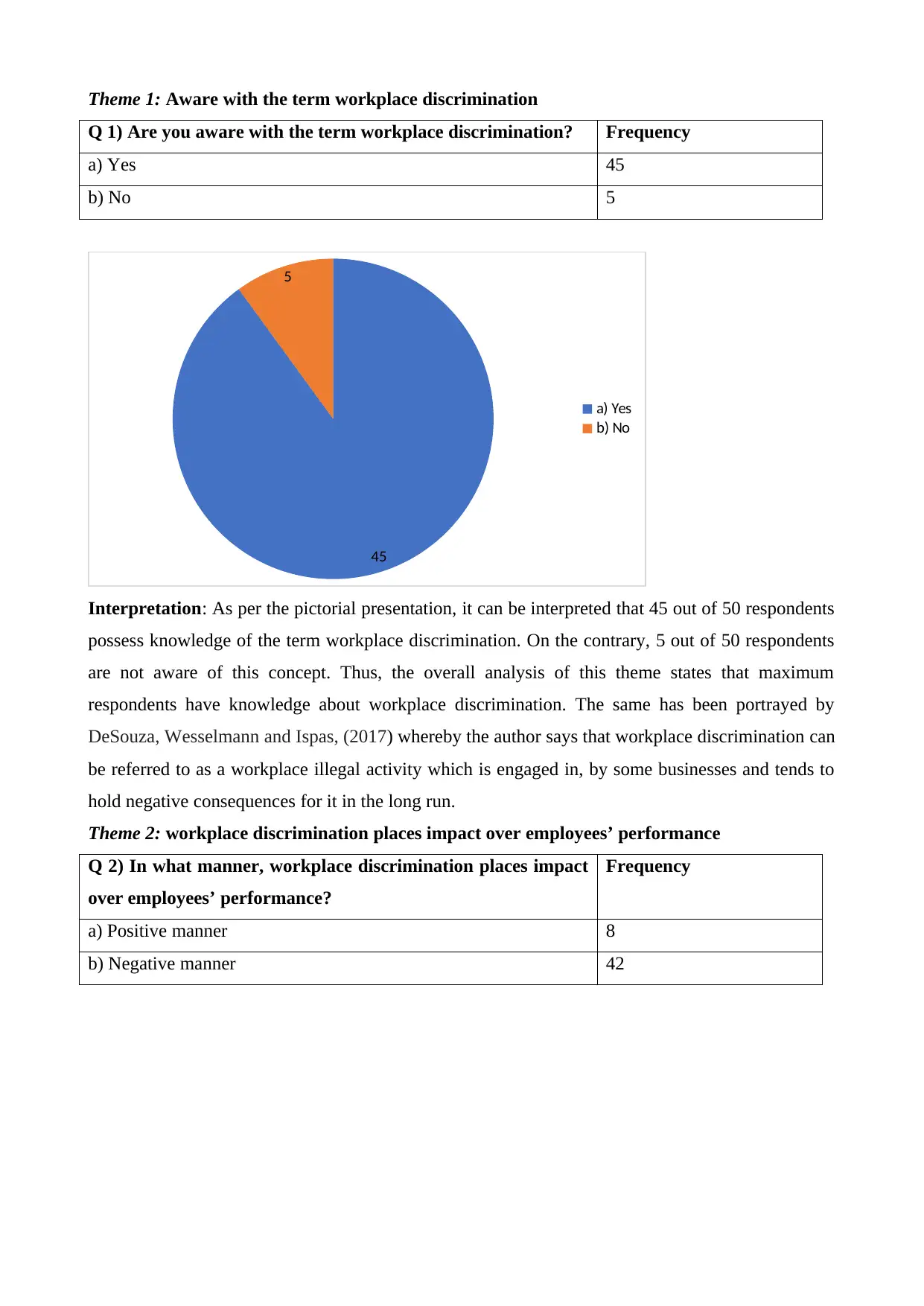
Theme 1: Aware with the term workplace discrimination
Q 1) Are you aware with the term workplace discrimination? Frequency
a) Yes 45
b) No 5
45
5
a) Yes
b) No
Interpretation: As per the pictorial presentation, it can be interpreted that 45 out of 50 respondents
possess knowledge of the term workplace discrimination. On the contrary, 5 out of 50 respondents
are not aware of this concept. Thus, the overall analysis of this theme states that maximum
respondents have knowledge about workplace discrimination. The same has been portrayed by
DeSouza, Wesselmann and Ispas, (2017) whereby the author says that workplace discrimination can
be referred to as a workplace illegal activity which is engaged in, by some businesses and tends to
hold negative consequences for it in the long run.
Theme 2: workplace discrimination places impact over employees’ performance
Q 2) In what manner, workplace discrimination places impact
over employees’ performance?
Frequency
a) Positive manner 8
b) Negative manner 42
Q 1) Are you aware with the term workplace discrimination? Frequency
a) Yes 45
b) No 5
45
5
a) Yes
b) No
Interpretation: As per the pictorial presentation, it can be interpreted that 45 out of 50 respondents
possess knowledge of the term workplace discrimination. On the contrary, 5 out of 50 respondents
are not aware of this concept. Thus, the overall analysis of this theme states that maximum
respondents have knowledge about workplace discrimination. The same has been portrayed by
DeSouza, Wesselmann and Ispas, (2017) whereby the author says that workplace discrimination can
be referred to as a workplace illegal activity which is engaged in, by some businesses and tends to
hold negative consequences for it in the long run.
Theme 2: workplace discrimination places impact over employees’ performance
Q 2) In what manner, workplace discrimination places impact
over employees’ performance?
Frequency
a) Positive manner 8
b) Negative manner 42
Paraphrase This Document
Need a fresh take? Get an instant paraphrase of this document with our AI Paraphraser
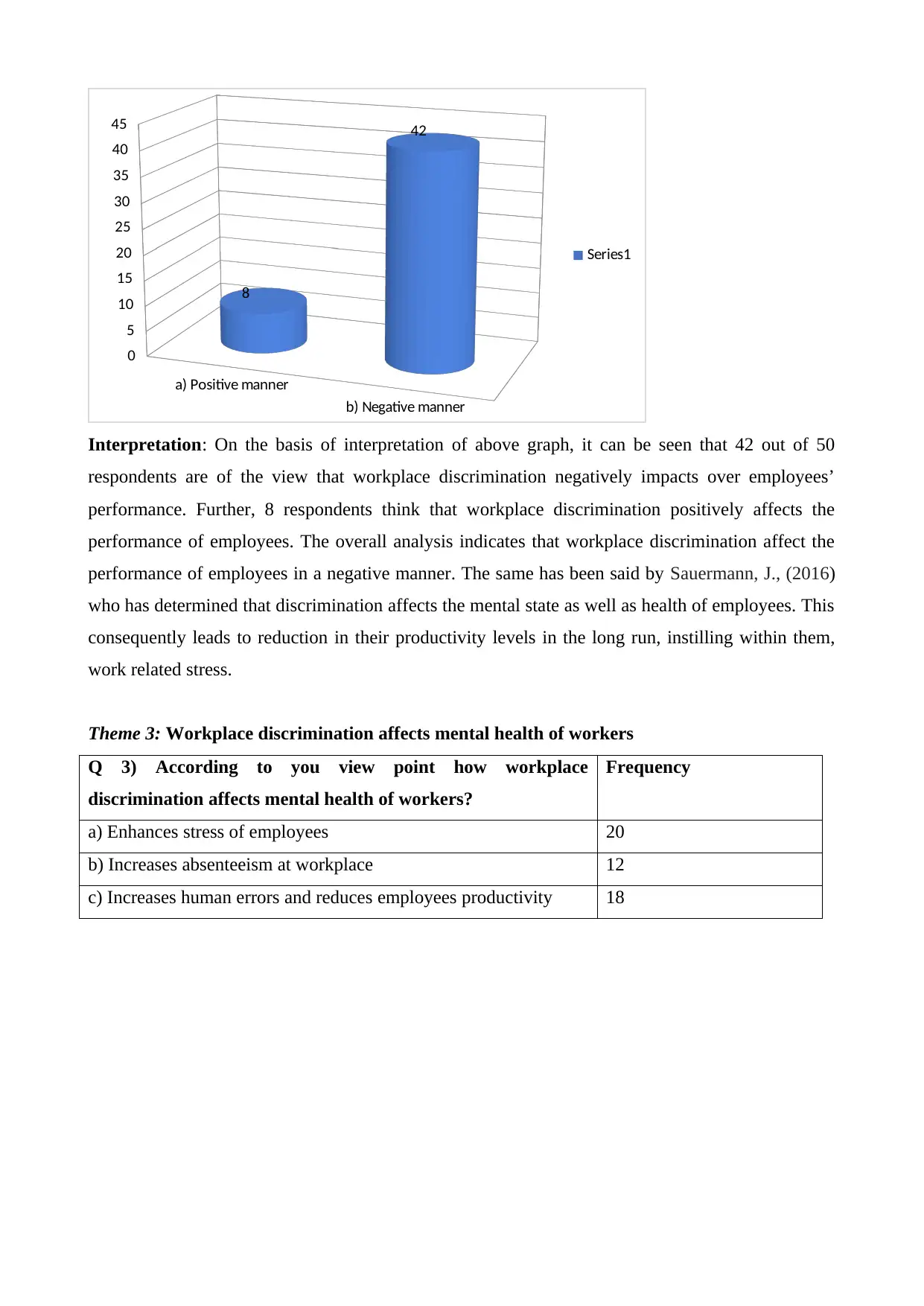
a) Positive manner
b) Negative manner
0
5
10
15
20
25
30
35
40
45
8
42
Series1
Interpretation: On the basis of interpretation of above graph, it can be seen that 42 out of 50
respondents are of the view that workplace discrimination negatively impacts over employees’
performance. Further, 8 respondents think that workplace discrimination positively affects the
performance of employees. The overall analysis indicates that workplace discrimination affect the
performance of employees in a negative manner. The same has been said by Sauermann, J., (2016)
who has determined that discrimination affects the mental state as well as health of employees. This
consequently leads to reduction in their productivity levels in the long run, instilling within them,
work related stress.
Theme 3: Workplace discrimination affects mental health of workers
Q 3) According to you view point how workplace
discrimination affects mental health of workers?
Frequency
a) Enhances stress of employees 20
b) Increases absenteeism at workplace 12
c) Increases human errors and reduces employees productivity 18
b) Negative manner
0
5
10
15
20
25
30
35
40
45
8
42
Series1
Interpretation: On the basis of interpretation of above graph, it can be seen that 42 out of 50
respondents are of the view that workplace discrimination negatively impacts over employees’
performance. Further, 8 respondents think that workplace discrimination positively affects the
performance of employees. The overall analysis indicates that workplace discrimination affect the
performance of employees in a negative manner. The same has been said by Sauermann, J., (2016)
who has determined that discrimination affects the mental state as well as health of employees. This
consequently leads to reduction in their productivity levels in the long run, instilling within them,
work related stress.
Theme 3: Workplace discrimination affects mental health of workers
Q 3) According to you view point how workplace
discrimination affects mental health of workers?
Frequency
a) Enhances stress of employees 20
b) Increases absenteeism at workplace 12
c) Increases human errors and reduces employees productivity 18
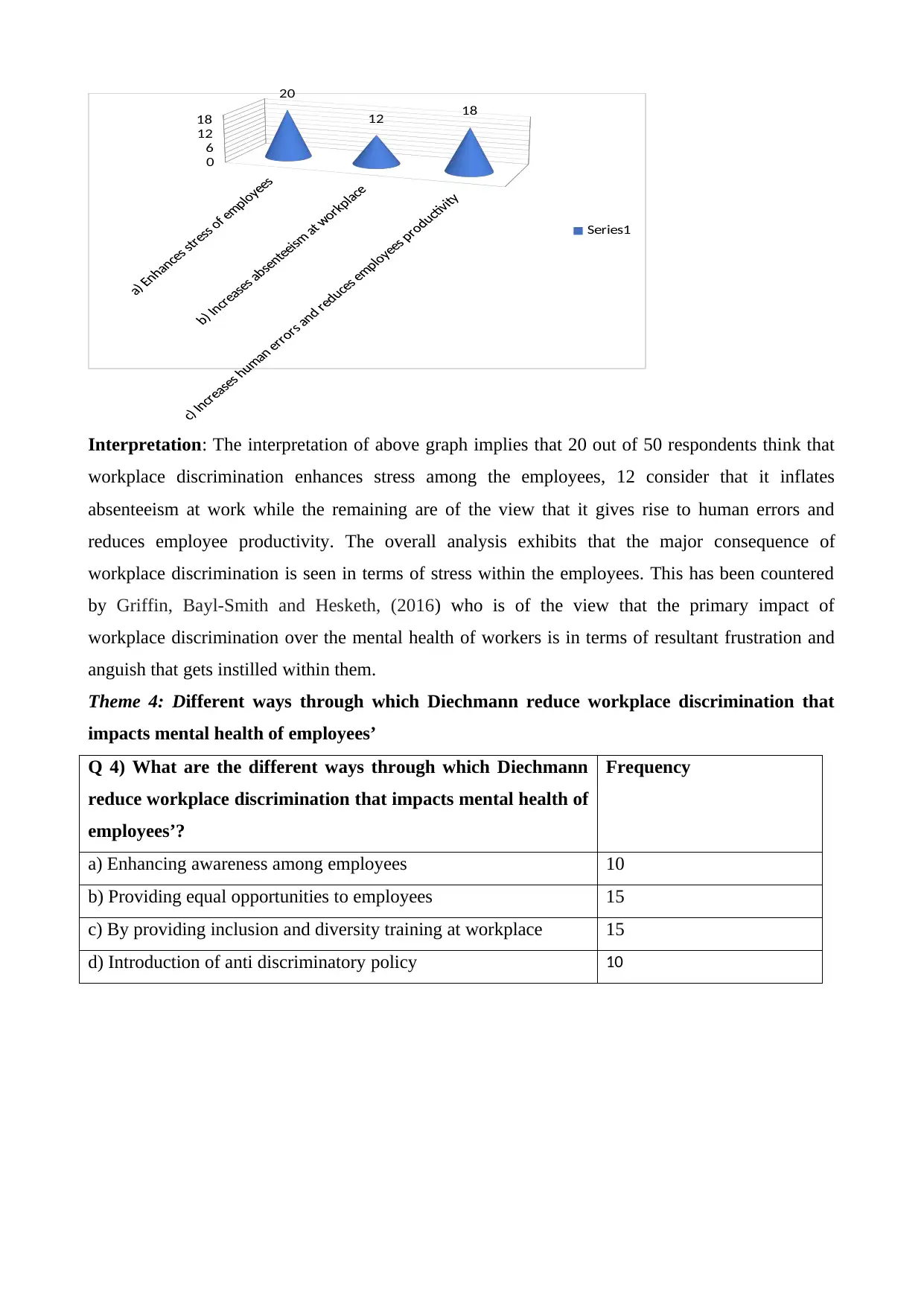
0
6
12
18
20
12 18
Series1
Interpretation: The interpretation of above graph implies that 20 out of 50 respondents think that
workplace discrimination enhances stress among the employees, 12 consider that it inflates
absenteeism at work while the remaining are of the view that it gives rise to human errors and
reduces employee productivity. The overall analysis exhibits that the major consequence of
workplace discrimination is seen in terms of stress within the employees. This has been countered
by Griffin, Bayl-Smith and Hesketh, (2016) who is of the view that the primary impact of
workplace discrimination over the mental health of workers is in terms of resultant frustration and
anguish that gets instilled within them.
Theme 4: Different ways through which Diechmann reduce workplace discrimination that
impacts mental health of employees’
Q 4) What are the different ways through which Diechmann
reduce workplace discrimination that impacts mental health of
employees’?
Frequency
a) Enhancing awareness among employees 10
b) Providing equal opportunities to employees 15
c) By providing inclusion and diversity training at workplace 15
d) Introduction of anti discriminatory policy 10
6
12
18
20
12 18
Series1
Interpretation: The interpretation of above graph implies that 20 out of 50 respondents think that
workplace discrimination enhances stress among the employees, 12 consider that it inflates
absenteeism at work while the remaining are of the view that it gives rise to human errors and
reduces employee productivity. The overall analysis exhibits that the major consequence of
workplace discrimination is seen in terms of stress within the employees. This has been countered
by Griffin, Bayl-Smith and Hesketh, (2016) who is of the view that the primary impact of
workplace discrimination over the mental health of workers is in terms of resultant frustration and
anguish that gets instilled within them.
Theme 4: Different ways through which Diechmann reduce workplace discrimination that
impacts mental health of employees’
Q 4) What are the different ways through which Diechmann
reduce workplace discrimination that impacts mental health of
employees’?
Frequency
a) Enhancing awareness among employees 10
b) Providing equal opportunities to employees 15
c) By providing inclusion and diversity training at workplace 15
d) Introduction of anti discriminatory policy 10
⊘ This is a preview!⊘
Do you want full access?
Subscribe today to unlock all pages.

Trusted by 1+ million students worldwide
1 out of 34
Related Documents
Your All-in-One AI-Powered Toolkit for Academic Success.
+13062052269
info@desklib.com
Available 24*7 on WhatsApp / Email
![[object Object]](/_next/static/media/star-bottom.7253800d.svg)
Unlock your academic potential
Copyright © 2020–2025 A2Z Services. All Rights Reserved. Developed and managed by ZUCOL.





